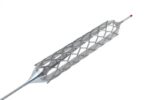The development of interventional cardiology has led us to successfully treat injuries and angiographic situations increasingly complex. This goes along that often the length of procedures is increasing automatically leading to increased fluoroscopy time and film images. The result, often unnoticed, is the possibility of the appearance of irradiation injuries in our patients or in...
Malapposition in drug-eluting stents. Much more common and much less serious than we thought
Original title: Incidences, Predictors, and Clinical Outcomes of Acute and Late Stent Malapposition Detected by Optical Coherence Tomography After Drug-Eluting Stent Implantation Reference: Im E. et al. CircCardiovascInterv. 2014 Jan 14. [Epubahead of print] This paper analyzed the imaging of 351 patients by optical coherence tomography (OCT) who received drug-eluting stents over 356 lesions between 2009 and...
Ischemic versus anatomical risk. Is anyone better to help us decide therapeutically?
Original title: Predicting Outcome in the COURAGE Trial. Coronary Anatomy Versus Ischemia. Reference: G. B. John Mancini et al. J Am Coll Cardiol Intv 2013, Article in press. Anatomical risk, ischemic amount or a combination of both, are often factors taken into account for estimating the prognosis or choose a treatment strategy. The COURAGE study (Clinical Outcomes Utilizing...
Everolimus-eluting stent and DEB in restenosis for BMS. Good results of both with some expected differences.
Original title: A Randomized Comparison of Drug-Eluting Balloon Versus Everolimus-Eluting Stent in Patients With Bare-Metal Stent In-Stent Restenosis: The RIBS V Clinical Trial. Reference: Fernando Alfonso et al. J Am Coll Cardiol. 2014; Epub ahead of print. Drug-eluting stents (DES) have proven to be superior in terms of restenosis than bare metal stents (BMS). BMS, however due...
Primary angioplasty with 2nd generation drug-eluting stents
Original title: Stent thrombosis with second-generation drug-eluting stents compared with bare-metal stents: Network meta-analysis of primary percutaneous coronary intervention trials in ST-segment–elevation myocardial infarction. Reference: Circ Cardiovasc Interv. 2013; Epub ahead of print. To compare the safety and efficacy of 2nd generation drug-eluting stents (DES) versus bare metal stents (BMS) in the context of primary angioplasty was conducted...
Similar results of drug-eluting stents with biodegradable polymer versus permanent
Original title: Biodegradable Polymer Biolimus-Eluting Stent Versus Durable Polymer Everolimus-Eluting StentA Randomized, Controlled, Noninferiority Trial.NEXT trial. Reference: Masahiro Natsuaki et al. J Am CollCardiol 2013;62:181–90. Drug-eluting stents with biodegradable polymer were designed to counteract the long-term adverse effects on the vascular wall of permanent polymer. This prospective, multicenter, randomized, non-inferiority design study, compared the biolimus eluting stent with...
Culprit artery only versus revascularization with ST segment elevation myocardial infarction. The discussion continues
Original title: Complete Versus Culprit-Only Revascularization for Patients with Multi-Vessel Disease Undergoing Primary Percutaneous Coronary Intervention for ST-Segment Elevation Myocardial Infarction: A Systematic Review and Meta-analysis. Reference: Kevin R et al. American Heart Journal, article in press. Primary angioplasty is the preferred reperfusion strategy in patients experiencing a STEMI as it has proven superior to fibrinolysis in reducing...
Silent cerebral embolism during percutaneous valve implantation does not appear to cause cognitive impairment
Original title: Cognitive trajectory after transcatheter aortic valve implantation. Reference: Ghanem A et al. Circulation Cardiovasc Intervent. 2013;Epub ahead of print Several studies showed that silent cerebral embolism in patients undergoing percutaneous aortic valve replacement is frequent but seems that does not affect the long-term cognitive functions according to this new study. This study included 111 patients...
Low cardiac mortality with bivalirudin beyond the reduction in major bleeding
Original title: Reduction in Cardiac Mortality with Bivalirudin in Patients With and Without Major Bleeding: The HORIZONS-AMI Trial. Reference: Gregg W. Stone et al. J Am Coll Cardiol. Epub ahead of print The HORIZONS -AMI study included 3602 patients experiencing ST segment elevation myocardial infarction received primary angioplasty, resulting in lower mortality at 30 days and three years...
Infarct size reduction to 30 days could result in clinical benefit at one year
Original title: Intralesional abciximab and thrombus aspiration in patients with large anterior myocardial infarction: One-year results from the INFUSE-AMI trial. Reference: Stone GW et al. Circ Cardiovasc Interv. 2013;Epub ahead of print. The intra-coronary infusion of Abciximab added to thromboaspiration seems to improve outcomes at one year in patients undergoing primary angioplasty for ST-segment elevation with anterior...









